The digital and social media marketing world once again came together at the 2016 ANA Digital & Social Media Conference to discuss what’s working in the digital space, what needs work, and how to tell the difference. Here are the key takeaways.
The digital and social media marketing world once again came together at the 2016 ANA Digital & Social Media Conference to discuss what’s working in the digital space, what needs work, and how to tell the difference. Here are the key takeaways.
– the book: The Five Hour Workday: Live Differently, Unlock Productivity, and Find Happiness
– the brain: Stephan Aarstol, the CEO and founder of Tower Paddle Boards. You might have seen Stephan on Shark Tank a few years ago. Although his pitch was considered a major screw-up by many (thanks to a computer glitch), he ended up with an investment from Mark Cuban. And Mark has gone on to say, “Stephan has done an amazing job growing Tower into a dominant industry force. He is one of my best Shark Tank investments.“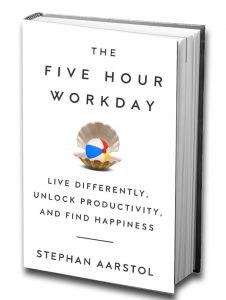
– the best bits: As you can surmise from the title, The Five Hour Workday is about just that — designing your company so it operates only five hours a day. It’s a practice that has produced great results since Stephan successfully implemented it at Tower a couple of years ago. He reports that because everyone at his company only works five hours a day:
He also believes the five hour workday practice has the potential to solve some of the biggest issues in business today including the sluggish economy, widespread lack of work-life balance, and gender inequality.
Stephan was inspired to rethink work practices when he learned about Henry Ford and his approach to running the Ford Motor Company. In an 1926 interview explaining why he reduced the working week in Ford plants to 40 hours with no cut in pay, Ford said:
The harder we crowd business for time, the more efficient it becomes. The more well-paid leisure workmen get, the greater become their wants. These wants soon become needs…[They] have the leisure to enjoy life and the wherewithal with which to finance that enjoyment.”
Stephan has now adopted a similar stance with the five hour workday. He writes:
You shouldn’t have to feel guilty for not working. You get to choose what you do in this life, for the most part. But in the current American culture, we seem to myopically be defined by how hard we work, and how much money we accumulate over the period of our lives…Most people are probably far better, and far more interested in other pursuits, than developing businesses or making money…That is what the five-hour workday is about. Getting the ‘have to’ work done as quickly and efficiently as possible, and then unlocking this other productivity of society that is largely hidden and repressed today.”
Sprinkled throughout the book are his observations, life philosophies, and advice for other business leaders.
– the brand story:
The story of Tower Paddle Boards is pretty incredible. Stephan started the company to put his SEO expertise to work by selling paddleboards directly to consumers at a significantly reduced price. In its first year the company did around $3,000/month in sales. It closed out the next year just short of $250,000 in sales, and in year three, it did $1.5 million.
Stephan then set his sights on transitioning Tower into a lifestyle brand, rolling out two to three product companies a year for a beach lifestyle — from flip flops to bikes — using the same business model. He’s already launched one, Sunglasses by Tower, and his company’s magazine Tower Magazine has over 25,000 subscribers.
He also wanted to create the best company culture in San Diego. He writes that he realized as a brand Tower was “telling customers to take life by the horns. To live more extraordinarily. To live differently. To play more. But were we really doing this ourselves?” He discovered that the five-hour workday was the key to “authentically lead by example. Leaving work at 1:00 p.m. every day would be an unavoidable daily reminder of the exact brand we aspired to be.”
Tower shows the kind of brand you can build when you combine a powerful market niche, a compelling brand vision, and an authentic commitment to corporate culture.
(In his book Stephan mentions my book, What Great Brands Do, and the brand-building principle “Great Brands Start Inside” as an inspiration while he re-thought his company culture. I couldn’t be prouder of Stephan and Tower and I’m so happy to hear about the impact I had on them.)
– the bottom line: The Five Hour Workday is a provocative book. Like me, you probably won’t agree with everything Stephan writes, but in no way should that diminish its significance as an important voice in the conversation about business today.
Listen to my interview with Stephan to learn:
P.S. You can learn more about Tower in my recent Forbes article.
The post brand book bites from the five hour workday appeared first on Denise Lee Yohn.
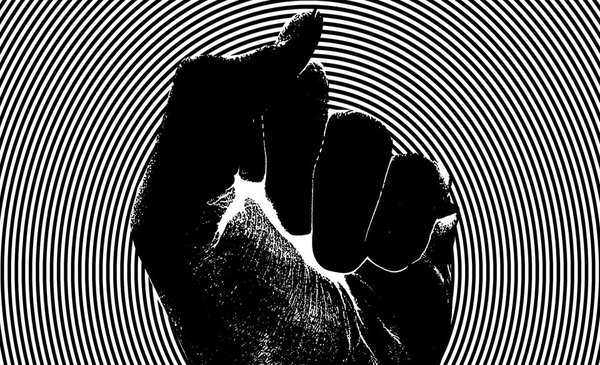
What have you got to say for yourself? How and when should a brand take a stand? And if you do, should you go hard or go soft? Talking is a critical part of brand behavior.
Soft Signals: Taking a stand this way is about clearly and simply stating the things that you cherish and value as a brand, in such a way that consumers have clear line of sight between what you say, what you offer, how you act and what you value. It’s positive. It’s connective. It’s constructive. It’s honest. It shows the strengths of your beliefs. Specifically, it signals your worldview. ‘We do this because …’ Or ‘we don’t do this because …’ It’s not emphatically saying we’re right or wrong. It puts opinions on the record and asks the consumer to sign up if they want to. It proves consistency.
Hard Signals: What polarizing brands do. They set out to set up sides and they do that by deliberately upsetting people, by getting under people’s skin, by provoking the response they want. Often they court publicity by working people’s biases – sometimes in a fun way, sometimes in a not so healthy way. They poke the finger. They call others out and signal they’re wrong. They accuse. They piss people off. It proves passion.
Both approaches work, but interestingly they work for consumers in different ways at different times. Because there are times and things we want our brands to be hard about, and times when we’d just like to softly know what they’re thinking. If we have passionate views of our own for example, we often side with brands that loudly articulate a similar viewpoint. That’s because we identify with the view they are expressing. It concurs with our own. We enjoy hearing them shout the odds. We urge them on.
On the other hand, there are times we just don’t want to hear too much about what a brand thinks. Providing they have a view that seems consistent with who they are, that’s enough. Often we feel like this about things that don’t really matter to us, or at least most of the time pass beneath or around our radar.
Brands need viewpoints. But they also need judgment. They need to know when it’s important to their consumers that they get on the soapbox, and when it is best to just have an opinion for those who are motivated enough to look.
Both hard and soft signals work, but in different ways at different times.
The same concern can call for very different stances from different industries. If you make toys, I’m very interested in your views on child labor, particularly if your products are made in some parts of the world. If you’re an accounting practice, I might still like to know what you think but, because it’s less directly relevant to what I buy from you, it might be less important to me to know what you’re doing about it.
Relevance Fuels Reaction. And Signals Expectation.
So if you do have a viewpoint that you hold to, and articulate loudly, you need to show your consumers why you’ve made it your business to get so hot under the collar about it. You need to connect the dots for them.
Markets are noisy. Everyone says you need to get consumers’ attention. They’re wrong. You need to get and hold consumers’ commitment. And sometimes the best way to do that is to shout what you think from the rooftops. And sometimes you just need to show you’re true to your word, and stop there and listen.
Just like in any relationship. Both sides need to talk. Sometimes loudly. Sometimes quietly. They just don’t need to behave and talk in the same way all the time. Or else the signals jam and someone switches off.
The Blake Project Can Help: The Strategic Brand Storytelling Workshop
Branding Strategy Insider is a service of The Blake Project: A strategic brand consultancy specializing in Brand Research, Brand Strategy, Brand Licensing and Brand Education
FREE Publications And Resources For Marketers
USAA, the financial services and insurance group, recently used Facebook and Instagram video ads to supplement its TV ads and honor the nation’s veterans. USAA wanted to reach a wider audience with its TV ads and raise brand awareness and favorability ahead of Veterans Day by encouraging nationwide support for those who served in the Armed Forces. In this session, Verchele Roberts, VP of Member Insights – USAA shared how this campaign drove strong incremental reach and positively impacted key brand metrics for USAA.
SponsorPitch shared a curated list of the biggest sponsorship and event marketing deals for the week of August 15th.
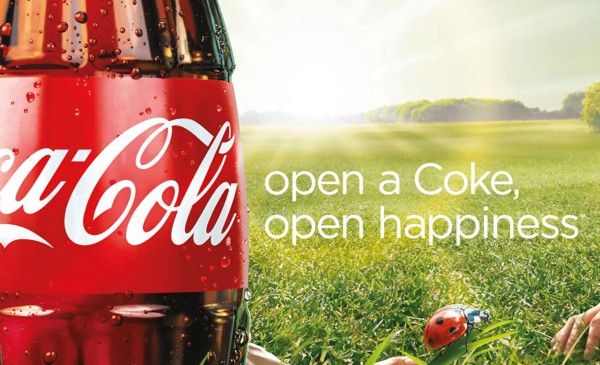
Great products sell themselves. No they don’t. But equally, people don’t just buy brands because they’re brands either.
Familiarity matters, but for the most part today’s customers are far too sophisticated to buy just anything with a nice or familiar name attached to it. Or rather to keep buying it without question.
A brand by itself doesn’t guarantee you anything.
Sometimes companies with brands that were once iconic forget that. They somehow believe that because the branding process can add margin, all brands must equal margin and presence must equal profit. Wrong. So wrong. Brands will only bring margin when everything else is right.
Right itself seems pretty straightforward. Make a really interesting brand promise. Deliver on it in really interesting ways. Do that, and the circle is seamless. Get it wrong and the circle is vicious.
When you don’t pay attention to the detail of your brand, there are consequences. The brand itself starts to break down. It degrades. To a name. And instead of a brand portfolio, all you’re really left with is a list masquerading as an asset base.
Making that list longer or wider doesn’t add to its value. It doesn’t mean you have diversified. It’s not a segmentation strategy. It just adds complexity, cost and confusion to what is now a catalog.
So what else can a brand do? Strategists tend to think of the other tools in the brand boosting toolbox in terms of repositioning or revamping the look and feel. But a question I’ve been pondering on for some time now is, “Could just the promise change?” If neither brands nor products can afford to remain static, it would make sense that promises can’t either. And yet the concept of re-promising (by itself and not necessarily accompanied by a fundamental shift in the brand positioning) doesn’t seem to come up that often in strategy conversations.
Maybe that’s the real lead-off question for brands looking to iterate effectively today. And it’s not about changing the promise for the sake of it. For this to work your brand will need to promise buyers something consumers will pay more for, or more often for, or both. (Coke did it beautifully with the shift from refreshment to happiness.) Because that’s the other simple human truth at play here of course: one that affects brands, products and promises alike. If you don’t give people valid reasons to pay more, they won’t.
The Blake Project Can Help: The Brand Positioning Workshop
Branding Strategy Insider is a service of The Blake Project: A strategic brand consultancy specializing in Brand Research, Brand Strategy, Brand Licensing and Brand Education
FREE Publications And Resources For Marketers
New York Times columnist, Perri Klass, M.D, explains why it’s so important to continue teaching cursive writing to young children:
“As a pediatrician, I think this may be another case where we should be careful that the lure of the digital world doesn’t take away significant experiences that can have real impacts on children’s rapidly developing brains. Mastering handwriting, messy letters and all, is a way of making written language your own, in some profound ways.”
Klass quotes Dr. Virginia Berninger, professor of educational psychology at the University of Washington:
“This myth that handwriting is just a motor skill is just plain wrong. We use motor parts of our brain, motor planning, motor control, but what’s very critical is a region of our brain where the visual and language come together, the fusiform gyrus, where visual stimuli actually become letters and written words.”
“What we’re advocating is teaching children to be hybrid writers, manuscript first for reading—it transfers to better word recognition—then cursive for spelling and for composing. Then, starting in late elementary school, touch-typing.”
Source: The New York Times(Blog) 06/20/2016
The post Why handwriting is still essential in the keyboard age appeared first on The Good For You Network.
Cross-posted from TEDWomen curator Pat Mitchell’s blog on the Huffington Post.
When Hanna Rosin, the first speaker at the very first TEDWomen conference in 2010, delivered her talk she had titled “The End of Men,” she had only just begun the research for what became her bestselling 2012 book by the same name.
And as the editors at The Guardian pointed out in a recent editorial, even though women are rising to the top in the US (Hillary Clinton), UK (Theresa May or Andrea Leadsom) and the UN (Helen Clark), “women’s leadership in politics, as well as in business, is not yet normal. But it is becoming normal.” Indeed, if Hillary Clinton is elected president and puts her 50% female cabinet in place, American women will see true representation proportional to population for the first time ever in a White House cabinet.
But as The Guardian editors cautioned in that same editorial, we shouldn’t make the mistake of allowing the “representation to be taken not as a victory, but as the victory.” We still have a long way to go.
Indeed, when Rosin’s book came out in 2012, it received much praise, but also some reductive criticism that mostly revolved around its title. NPR’s Annalee Newitz wrote in her review of the book, “fundamentally, The End of Men isn’t about men at all; it’s about the rise of economically powerful women.”
As Rosin explained in both her TEDdWomen talk and in her book, the big story for women in the 21st century is that more education (for every two men who graduate from college, three women graduate), more leadership opportunities (women make up more than 50% of managers in the workplace) and more economic security (younger women are out-earning their male peers) mean that women can make choices in their lives with more freedom than ever before.
Since her TEDWomen presentation, Rosin has appeared on The Colbert Report, become the co-host of Slate‘s excellent DoubleX podcast in which Rosin and her cohosts, writers June Thomas and Norene Malone, “discuss things women want to talk about and men want to eavesdrop on,” and continued writing award-winning articles on a variety of topics, including the secret lives of teenagers and challenging modern parenting practices.
This summer, Rosin herself did something rather daring that may be the best example yet of the opportunities that economically powerful women have these days. After 20-plus years of writing for a living, she decided to make a leap and accepted a job offer in a field in which she had no previous experience. Rosin is now one of the hosts of NPR’s popular and award-winning Invisibilia podcast series. Having never been a radio journalist before, the move presented a number of challenges for Rosin. She wrote about them earlier this summer in Lena Dunham’s Lenny newsletter in a piece titled “Screw Mastery.”
While getting outside her comfort zone was hard, Rosin noted that the payoff of, as she put it, “dropping back to zero” and forcing yourself to learn new things, even in your 40s, made the successes that much sweeter. She wrote,
I learned a ton of new things about myself, in the way you can only do if you are f—king up daily. I learned that I am defensive but trainable. That I have capacity for patience but that my immediate default is speed, bluntness and ironic distance. That although I am used to working alone, I will happily collaborate. And that I really like working with women, even if they cry more during the day.”
The support system of having women in leadership positions mentoring her at Invisibilia has made all the difference for Rosin. She writes, “I got a lot of help. The people I work with taught me things the way you teach a kid to ride a bicycle — they were right on top of me, day after day. Still, nine months later I listen to the shows we produced and I can completely recognize them as my own.”
Watch her 2010 TEDWomen talk.
TEDWomen 2016 continues a journey that began in Washington, D.C., in 2010, the first major TED conference to focus on the ideas, stories and global narrative of women and girls. The response was overwhelming! Our speakers, both women and men, have come from many different backgrounds and experiences to share ideas and stories in TEDTalks that have been viewed more than 60 million times on TED.com.
Our theme for TEDWomen 2016 is “It’s about time.” We will be exploring how time and attention shape our very lives. In theory, we’ve all got an equal amount of time — 24 precious hours in a day — and yet, our capacity to harness the most out of it is wildly different depending on our circumstances and state of mind. Together, we’ll plot how to push the tipping points even faster and move even slower when it comes to the things we most want to savor and care about.
If you’re interested in being present for these TEDTalks and many more on this year’s theme, there are still a few spaces left to attend TEDWomen 2016. (After the theater is completely sold out, we will also offer some discounted tickets for simulcast viewing.) We will announce our speaker lineup next week — find out more and register at TED.com.
This installment in my blog post series on how to scale-up your brand introduces two brand tools. Use them in your process of developing or refining the strategic platform of your brand. They will help you identify and clearly articulate your brand purpose, values, and attributes.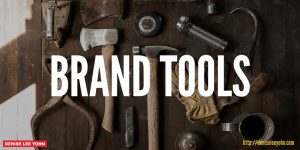
Let’s begin with some definitions:
These three elements comprise your brand identity, which is one half of the strategic platform of your brand. Your brand positioning is the other half of your strategic brand platform. Together they form the building blocks that create a strong, differentiated, valuable brand.
Exercises like the ones I describe below are helpful in developing these brand building blocks because they cause participants to be more thoughtful about the brand they’re creating and why — and they help people be more articulate and specific as they describe their brand vision.
I recommend forming a team of 3-6 people to work through these exercises together. Include key brand stakeholders — i.e., people who have a key stake in the success of your brand — such as the founders, executives, employees, investors, strategic partners, perhaps even a select customer or two. Sometimes it’s helpful to include an objective facilitator to encourage open and active participation and/or an inspirational muse to contribute out-of-the box ideas.
The goal is to get everyone’s insights and input on the brand out on the table and to develop a clear shared vision for the strategic brand platform. The process of doing the exercises together creates shared understanding and ensures that different perspectives are considered in the development of the platform. One final note: The exercises are simply tools to cultivate robust discussion. If you find your group deviating from the exercise process but having a great discussion about the brand anyway, go with the flow — you’ll likely end up in the same place. Likewise, don’t just go through the motion of the exercises without ensuring that they prompt productive conversation.
Exercise #1: The first exercise is called “THINK. FEEL. DO.” It’s a Thematic Apperception “Test” (TAT) borrowed from the world of psychology. It’s a projective exercise, meaning that it helps to reveal underlying motives, appeals, and concerns. Most TATs use ambiguous pictures of people and ask participants to make up narratives about the images.
To help uncover a brand’s purpose and values, use stick figure pictures of a brand customer now and in the future. Participants should make up narratives about the person’s thoughts, feelings, and actions before and after the brand launch (or before and after he becomes of aware of the brand and tries it) — i.e., what is he thinking, what is he feeling, and what is he doing.
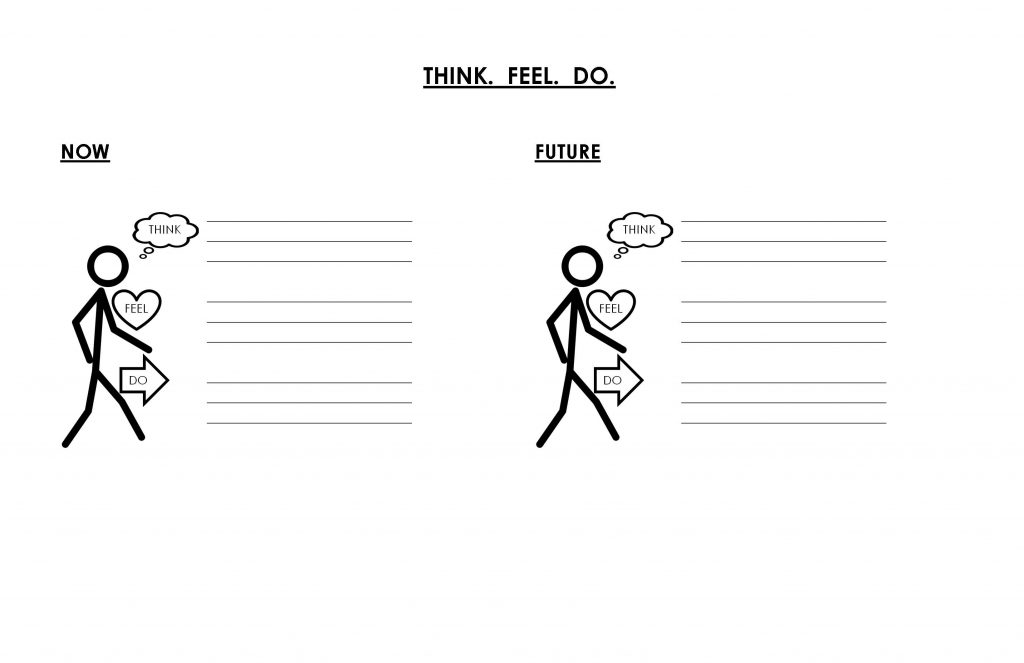
Even though developing your brand platform should be a fun and creative process and the use of stick figures in this exercise specifically may seem playful, encourage participants to think deeply as they create the narratives. You really want to get at the change in the world they see the brand making and how the brand makes it. For example, in the post-launch “Do” section, get beyond the basic outcome that customers will go buy the brand once it’s available. Consider how the brand might change their lives — how they might relate to themselves, people, and/or their environments differently; or what decisions they might make differently; how they might spend their time or money differently.
Look for similarities and differences among the narratives; discuss the appeal of the similarities and the reasons for the differences. Extract from the discussion key themes that form the brand purpose.
Tips:
Exercise #2: The second exercise, IS/IS NOT, uses an adjective checklist to identify the values and attributes that define the way the brand behaves and distinguish the brand.
Participants are given a list of 50-75 descriptive adjectives and asked to circle up to 5 adjectives that describe what it IS and cross out up to 5 adjectives that it IS NOT. You can also give them the option of writing in their own words, but they should do so only if they believe an important factor is not represented by any of the words on the page and they should use single-word, descriptive adjectives.

The effectiveness of this exercise depends on the list of adjectives given to participants. Below is an example of a list I used for a new brand of healthful snacks. Usually I select words that:
I avoid words like “authentic” and “cool” for reasons that this post explains. I also don’t include “fun” or “passionate” unless the degree to or nature with which the brand would embrace these ideas is particularly distinguishing.
As with Exercise #1, look for similarities and differences among people’s choices; discuss the relevance of the similarities and the subtleties for the differences. Extract from the discussion key descriptors that make up the brand values and attributes.
Tip:
Coming up next in the “Scale Up Your Brand” series is another brand tools. If you want to mbe notified when I publish the post, consider subscribing to my feed.
previous posts:
The post scale-up your brand — set your brand purpose, values, and attributes appeared first on Denise Lee Yohn.